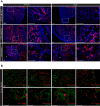The Tcf21 lineage constitutes the lung lipofibroblast population
- PMID: 30675802
- PMCID: PMC6589586
- DOI: 10.1152/ajplung.00254.2018
The Tcf21 lineage constitutes the lung lipofibroblast population
Abstract
Transcription factor 21 (Tcf21) is a basic helix-loop-helix transcription factor required for mesenchymal development in several organs. Others have demonstrated that Tcf21 is expressed in embryonic lung mesenchyme and that loss of Tcf21 results in a pulmonary hypoplasia phenotype. Although recent single-cell transcriptome analysis has described multiple mesenchymal cell types in the lung, few have characterized the Tcf21 expressing population. To explore the Tcf21 mesenchymal lineage, we traced Tcf21-expressing cells during embryogenesis and in the adult. Our results showed that Tcf21 progenitor cells at embryonic day (E)11.5 generated a subpopulation of fibroblasts and lipofibroblasts and a limited number of smooth muscle cells. After E15.5, Tcf21 progenitor cells exclusively become lipofibroblasts and interstitial fibroblasts. Lipid metabolism genes were highly expressed in perinatal and adult Tcf21 lineage cells. Overexpression of Tcf21 in primary neonatal lung fibroblasts led to increases in intracellular neutral lipids, suggesting a regulatory role for Tcf21 in lipofibroblast function. Collectively, our results reveal that Tcf21 expression after E15.5 delineates the lipofibroblast and a population of interstitial fibroblasts. The Tcf21 inducible Cre mouse line provides a novel method for identifying and manipulating the lipofibroblast.
Keywords: fibroblast; lipofibroblast; lung; perilipin 2; transcription factor 21.
Conflict of interest statement
No conflicts of interest, financial or otherwise, are declared by the authors.
Figures








Comment in
-
The lipofibroblast: more than a lipid-storage depot.Am J Physiol Lung Cell Mol Physiol. 2019 May 1;316(5):L869-L871. doi: 10.1152/ajplung.00109.2019. Epub 2019 Mar 6. Am J Physiol Lung Cell Mol Physiol. 2019. PMID: 30840482 No abstract available.
Similar articles
-
Evidence for the involvement of fibroblast growth factor 10 in lipofibroblast formation during embryonic lung development.Development. 2015 Dec 1;142(23):4139-50. doi: 10.1242/dev.109173. Epub 2015 Oct 28. Development. 2015. PMID: 26511927 Free PMC article.
-
The bHLH transcription factor Tcf21 is required for lineage-specific EMT of cardiac fibroblast progenitors.Development. 2012 Jun;139(12):2139-49. doi: 10.1242/dev.079970. Epub 2012 May 9. Development. 2012. PMID: 22573622 Free PMC article.
-
Mesodermal ALK5 controls lung myofibroblast versus lipofibroblast cell fate.BMC Biol. 2016 Mar 16;14:19. doi: 10.1186/s12915-016-0242-9. BMC Biol. 2016. PMID: 26984772 Free PMC article.
-
TCF21: a critical transcription factor in health and cancer.J Mol Med (Berl). 2020 Aug;98(8):1055-1068. doi: 10.1007/s00109-020-01934-7. Epub 2020 Jun 15. J Mol Med (Berl). 2020. PMID: 32542449 Review.
-
Role of the bHLH transcription factor TCF21 in development and tumorigenesis.Braz J Med Biol Res. 2021 Mar 15;54(5):e10637. doi: 10.1590/1414-431X202010637. eCollection 2021. Braz J Med Biol Res. 2021. PMID: 33729392 Free PMC article. Review.
Cited by
-
Evasion of apoptosis by myofibroblasts: a hallmark of fibrotic diseases.Nat Rev Rheumatol. 2020 Jan;16(1):11-31. doi: 10.1038/s41584-019-0324-5. Epub 2019 Dec 2. Nat Rev Rheumatol. 2020. PMID: 31792399 Free PMC article. Review.
-
Kindlin for the Fire: Targeting Proline Synthesis to Extinguish Matrix Production in Pulmonary Fibrosis.Am J Respir Cell Mol Biol. 2021 Jul;65(1):4-5. doi: 10.1165/rcmb.2021-0137ED. Am J Respir Cell Mol Biol. 2021. PMID: 33844940 Free PMC article. No abstract available.
-
iPSC-derived mesenchymal cells that support alveolar organoid development.Cell Rep Methods. 2022 Sep 19;2(10):100314. doi: 10.1016/j.crmeth.2022.100314. eCollection 2022 Oct 24. Cell Rep Methods. 2022. PMID: 36313800 Free PMC article.
-
Maladaptive functional changes in alveolar fibroblasts due to perinatal hyperoxia impair epithelial differentiation.JCI Insight. 2022 Mar 8;7(5):e152404. doi: 10.1172/jci.insight.152404. JCI Insight. 2022. PMID: 35113810 Free PMC article.
-
Modulation of retinoid signaling: therapeutic opportunities in organ fibrosis and repair.Pharmacol Ther. 2020 Jan;205:107415. doi: 10.1016/j.pharmthera.2019.107415. Epub 2019 Oct 16. Pharmacol Ther. 2020. PMID: 31629008 Free PMC article. Review.
References
-
- Acharya A, Baek ST, Huang G, Eskiocak B, Goetsch S, Sung CY, Banfi S, Sauer MF, Olsen GS, Duffield JS, Olson EN, Tallquist MD. The bHLH transcription factor Tcf21 is required for lineage-specific EMT of cardiac fibroblast progenitors. Development 139: 2139–2149, 2012. doi:10.1242/dev.079970. - DOI - PMC - PubMed
-
- Al Alam D, El Agha E, Sakurai R, Kheirollahi V, Moiseenko A, Danopoulos S, Shrestha A, Schmoldt C, Quantius J, Herold S, Chao CM, Tiozzo C, De Langhe S, Plikus MV, Thornton M, Grubbs B, Minoo P, Rehan VK, Bellusci S. Evidence for the involvement of fibroblast growth factor 10 in lipofibroblast formation during embryonic lung development. Development 142: 4139–4150, 2015. doi:10.1242/dev.109173. - DOI - PMC - PubMed
Publication types
MeSH terms
Substances
Grants and funding
LinkOut - more resources
Full Text Sources
Other Literature Sources
Molecular Biology Databases
Research Materials

